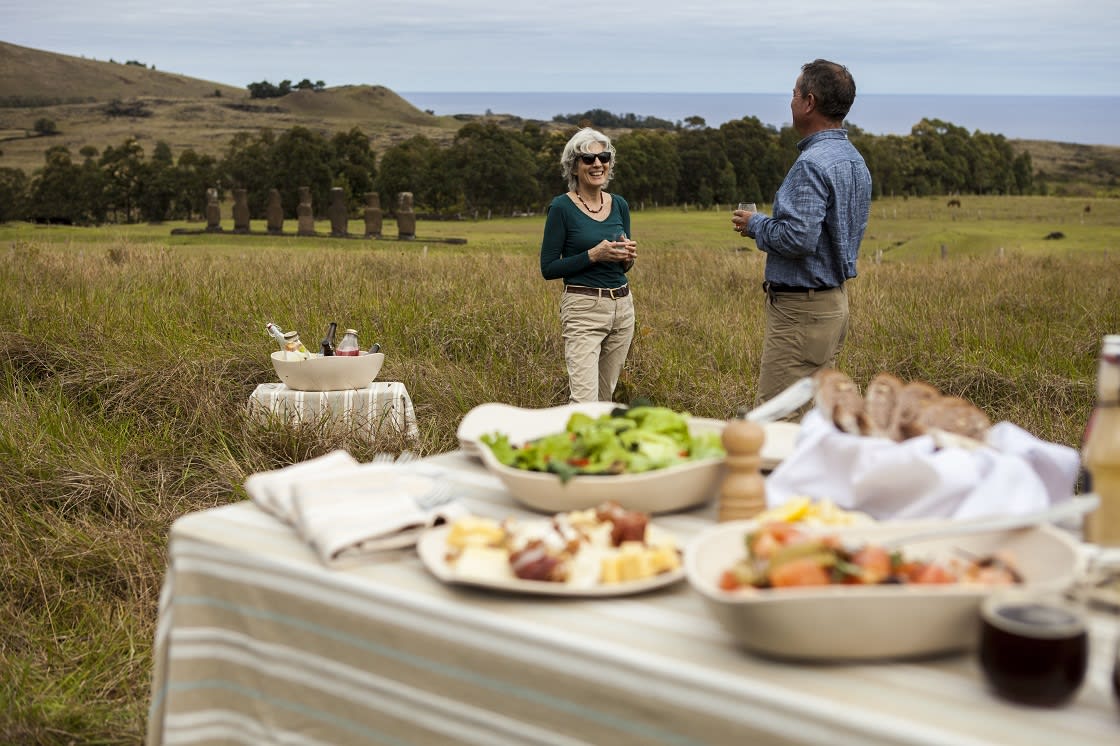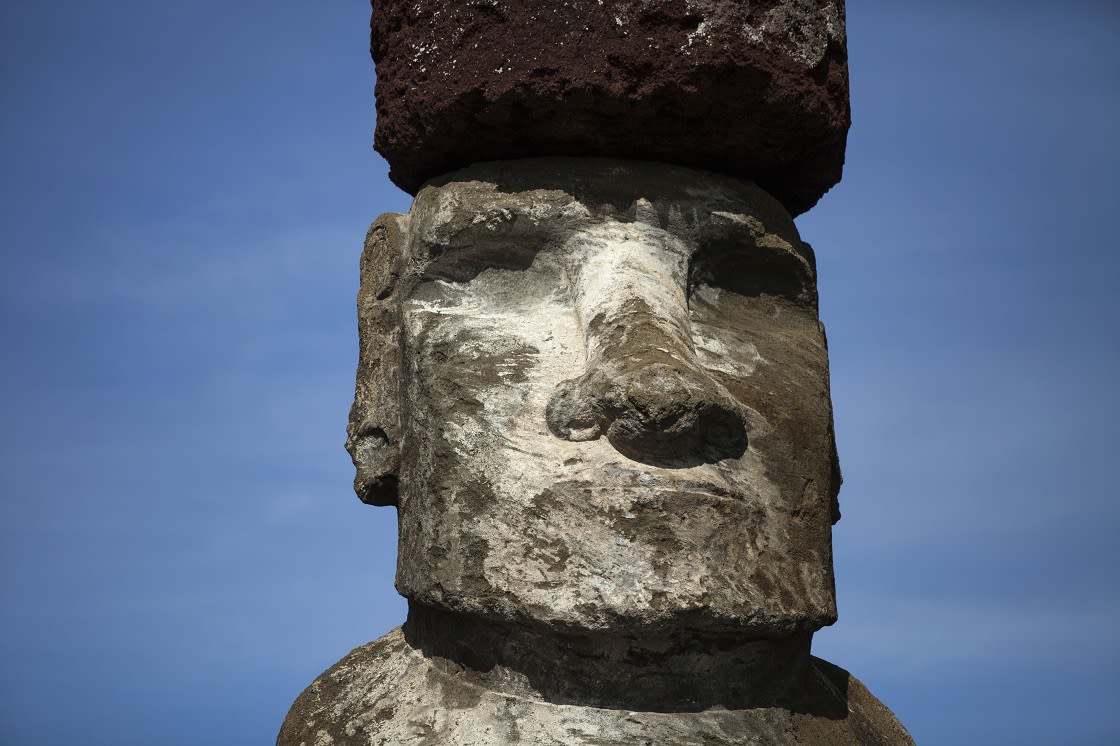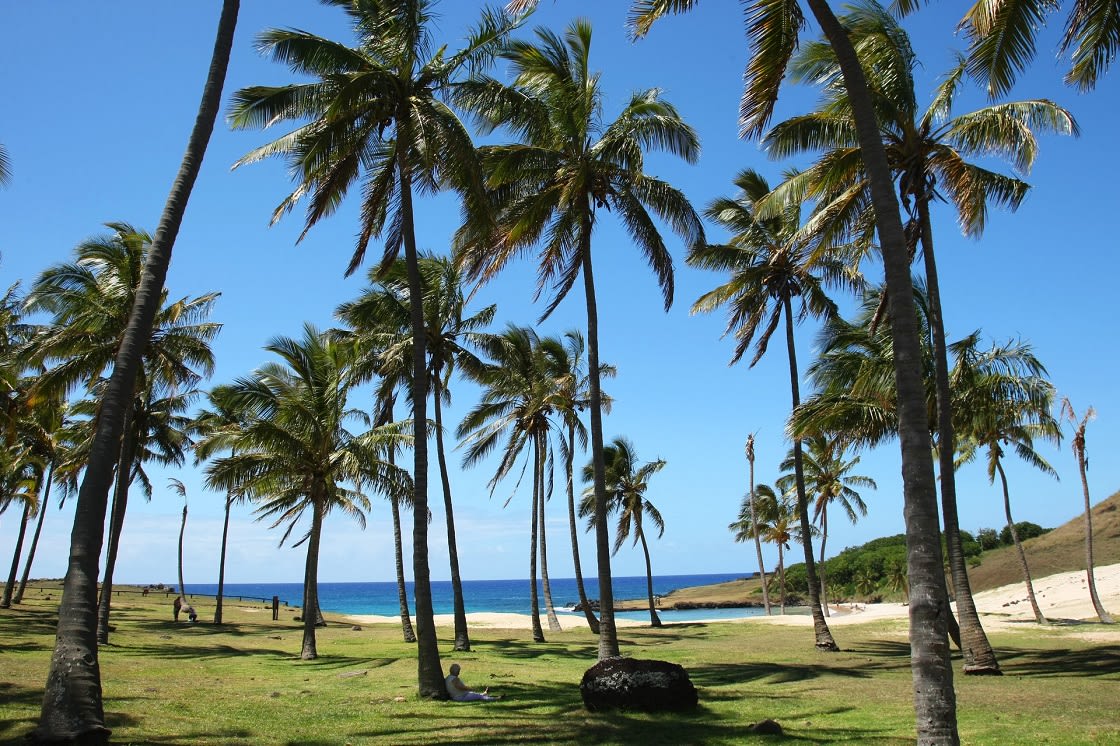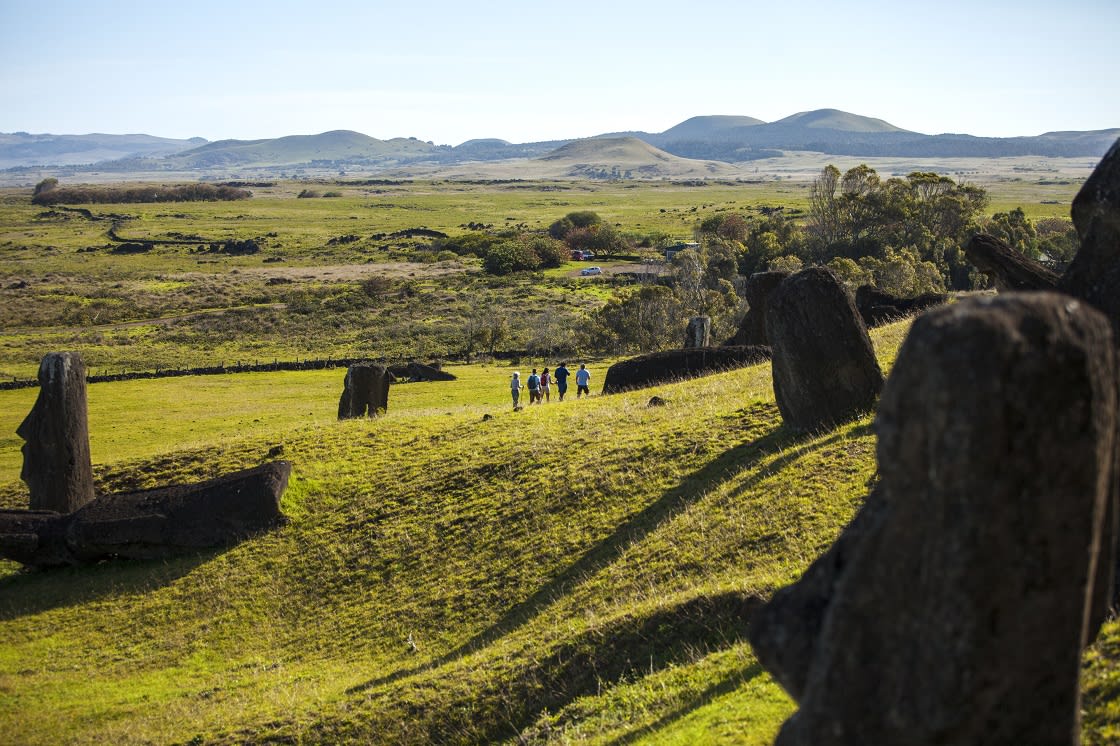
Easter Island, a small volcanic island in the middle of the Pacific Ocean, is world-famous for its giant ‘moai’ statues, which were built during the 13th – 16th centuries by the island’s inhabitants, the Rapa Nui people, in honor of their ancestors. The moai stood on stone platforms called ahus. All of the moai on the platforms were toppled by the Rapa Nui in the 1830s due to tribal wars and a loss of faith in their ancestors. During the late 1900s, moai at several sites were restored to their original platforms by locals and archaeologists. Here’s a list of the best Easter Island places to visit:
Ahu Tahai is the closest moai site to Hanga Roa, the island’s main town and harbor. Here you will find three ‘ahu’ or ceremonial platforms: Ahu Vai Uri has five moai found at the Tahai archaeological site: Ahu Tahai has a single moai, and Ahu Ko Te Riku is the only moai on the island that has eyes. The eyes are made from white coral and the pupils are from obsidian. When the eyes were inserted, the statue was believed to come to life, holding the spiritual power to protect its tribe.

Special Lunch At Ahu Akivi By Explora
Ahu Akivi is the only platform where the moai face the sea. The statues on this platform are the same shape and height, creating a sense of balance. Ahu Akivi was the first ceremonial platform to be restored, which led to the restoration of more platforms, attracting the attention of international researchers and tourists.
Te Pito Kura is a rock, which is believed to contain spiritual magnetic energy known as ‘mana’. Due to its high iron content, this stone warms up more than surrounding stones and causes compasses to behave strangely. Some people believe that touching the stone increases fertility but touching it is now forbidden.
Puna Pau is a small extinct volcano, located northeast of Hanga Roa. Once considered a sacred and secret place, this crater is part of a set of parasitic cones that emerged during the eruptions of Ma’unga Terevaka, the youngest and highest volcano on Easter Island. Inside the Puna Pau crater, there is a quarry of red scoria that was once an important source of raw material for the islanders, a type of volcanic ash of great porosity and scarce hardness, which is a reddish color due to the iron oxide present in its composition. This soft, easy-to-carve rock was used to make topknots (or hats) that crowned the heads of some moai as well as their eyes. Around the site, you will see large red cylinders just lying around.
A short walk from Ahu Tahai or the museum is Hanga Kio’e, where you can see a single moai called Ahu Akapu. You can also see an eroded piece of a moai on Ahu Hanga Kio’e.
The Father Sebastian Englert Anthropological Museum, close to Hanga Roa town, is Easter Island’s only museum, showcasing preserved artifacts that have been found on the island such as obsidian stone tools, ancient fish hooks as well as the face of a moai with a coral eye, which was discovered on Anakena Beach during the restoration of Ahu Nau Nau. An interesting artifact on display is a female moai, one of only twelve that have been found on Easter Island.
At Aka Hanga, you’ll find the remains of what was once an old village near a small bay (hanga), located on the south coast of the island. At the entrance of the enclosure, after crossing the wall, there are the stone foundations of several boat-houses, so-called because of their elliptical shape reminiscent of a ship, where the old inhabitants lived. In front of the access of each house, there is a small area paved with round marine boulders, which form a square. Nearby stands Ahu Akahanga, a large unrestored 60-ft-long platform. On the ground, there are 13 moai that once stood proudly on top of the platform. They were toppled both face-up and face-down, unlike other destroyed platforms where the statues were knocked over face down to hide their faces.

Ahu Tongariki
The most famous and best-preserved Moai site is Ahu Tongariki, and this is the picture that you will see on nearly every postcard rack on Easter Island. Here, 15 complete statues stand in an impressive line on their ahu plinth in front of the ocean and cliffs. This is a wonderful place to watch the sunrise and one of the must-see Easter Island sites. The moais were toppled during the island’s civil wars, and in the twentieth century, the ahu was swept more than 100 yards inland by a tsunami. It has since been restored and the moai here includes one that weighs 85 tons, the heaviest ever erected on the island. Between 1992 and 1996, the site of Ahu Tongariki was carefully restored. The moai at Ahu Tongariki come in a variety of shapes. Some are tall, some are short, some are thin, some are wide, and they all have different expressions. Near the entrance, you will see a single moai that is known as “the traveling moai” because it was sent to Japan in 1982 to appear in an exhibition in Osaka.

Anakena Beach
Ahu Nau Nau is an ahu platform at Anakena Beach, which is one of only two sandy beaches on Easter Island. Surrounded by tall coconut palms imported from Tahiti, Anakena is the perfect place to spend some time relaxing on the beach. If you’re brave enough, you can go swimming in the cold ocean. At Anakena, there are two important moai sites: Ahu Nau Nau and Ahu Ature. Ahu Nau Nau is the best-preserved platform on the island because the toppled statues were buried under sand for many years, protecting them from damage. As a result, the ears, fingers, nipples, and noses of those moai are far more defined than most moai. There are also distinctive patterns carved onto the backs of the moai. Three of these moai have topknots.

Hike To Rano Raraku By Explora Rapa Nui
Rano Raraku volcano is considered one of the most important archaeological sites in the world. This is the quarry where the moai were carved and sculpted and where the world-famous “stone heads” are located. The quarry contains 397 moai statues which are all at various stages of carving. Walking along the path that leads to the ancient crater is like being in an open-air museum. Te Tokanga, the largest moai ever carved, can be found here but probably because it was too heavy, it was never removed from the quarry. At the highest point of the quarry, you will see a breathtaking view of Ahu Tongariki and the ocean.
At Rano Raraku you can see a very special moai called Tukuturi. He is unique because his features are more realistic than any other moai. He has a round face and a beard and is kneeling with his hands on his legs. Tukuturi was sculpted from rock from Puna Pau quarry, which is completely different from the material used to sculpt the other moai. Near the entrance to Rano Raraku, you can take a short walk to see the enormous crater of the volcano that offers incredible views out to sea. If you’re hoping to take some good photos, it’s best to go early in the morning or late afternoon for the best light. On a slope near the volcano, you can see more moai that are facing the lagoon.
High up on the side of Rano Kau, the largest volcano on Easter Island, is the historic Orongo village. Here you can find more than 50 stone dwellings looking out over the sea and towards some rocky offshore islands. This ceremonial village is where the ancient ‘Birdman’ competition was held. This contest would pit representatives from each village on the island against each other in a dangerous climbing and swimming match. They had to climb down the steep, 1000-ft cliff, swim through the ocean to one of the islands off the coast, wait until the first egg of the season was laid, and the first man to collect one would be the winner and would become governor of the island for the year.
While Rainforest Cruises aim to provide accurate and up-to-date information, we make no representations as to the accuracy or completeness of any information herein or found by following any link on this site. Rainforest Cruises cannot and will not accept responsibility for any omissions or inaccuracies, or for any consequences arising therefrom, including any losses, injuries, or damages resulting from the display or use of this information.




